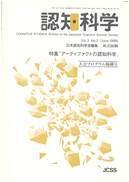3 巻, 2 号
選択された号の論文の11件中1~11を表示しています
- |<
- <
- 1
- >
- >|
巻頭言
-
1996 年3 巻2 号 p. 2_1-2_2
発行日: 1996/05/31
公開日: 2008/10/03
PDF形式でダウンロード (115K)
特集―アーティファクトの認知科学
-
1996 年3 巻2 号 p. 2_3-2_4
発行日: 1996/05/31
公開日: 2008/10/03
PDF形式でダウンロード (142K) -
1996 年3 巻2 号 p. 2_5-2_24
発行日: 1996/05/31
公開日: 2008/10/03
PDF形式でダウンロード (1963K) -
1996 年3 巻2 号 p. 2_25-2_35
発行日: 1996/05/31
公開日: 2008/10/03
PDF形式でダウンロード (957K) -
1996 年3 巻2 号 p. 2_36-2_49
発行日: 1996/05/31
公開日: 2008/10/03
PDF形式でダウンロード (1534K) -
1996 年3 巻2 号 p. 2_50-2_61
発行日: 1996/05/31
公開日: 2008/10/03
PDF形式でダウンロード (1089K) -
1996 年3 巻2 号 p. 2_62-2_82
発行日: 1996/05/31
公開日: 2008/10/03
PDF形式でダウンロード (3451K)
研究論文
-
1996 年3 巻2 号 p. 2_83-2_95
発行日: 1996年
公開日: 2008/10/03
PDF形式でダウンロード (2042K)
誌上討論
-
1996 年3 巻2 号 p. 2_96-2_100
発行日: 1996/05/31
公開日: 2008/10/03
PDF形式でダウンロード (402K)
書評
-
1996 年3 巻2 号 p. 2_101-2_102
発行日: 1996/05/31
公開日: 2008/10/03
PDF形式でダウンロード (178K)
会議報告
-
1996 年3 巻2 号 p. 2_103-2_104
発行日: 1996/05/31
公開日: 2008/10/03
PDF形式でダウンロード (126K)
- |<
- <
- 1
- >
- >|
